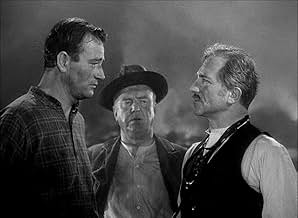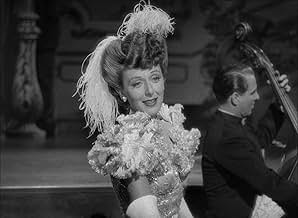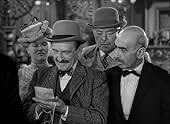IMDb RATING
6.2/10
1.7K
YOUR RATING
A cowboy competes with a gambling tycoon on the Barbary Coast for the hand of a beautiful dance-hall queen.A cowboy competes with a gambling tycoon on the Barbary Coast for the hand of a beautiful dance-hall queen.A cowboy competes with a gambling tycoon on the Barbary Coast for the hand of a beautiful dance-hall queen.
- Nominated for 2 Oscars
- 2 nominations total
Abdullah Abbas
- Saloon Patron
- (uncredited)
Eddie Acuff
- Fireman
- (uncredited)
Doc Adams
- Saloon Patron
- (uncredited)
- Director
- Writers
- All cast & crew
- Production, box office & more at IMDbPro
Featured reviews
"Flame of the Barbary Coast" is a movie that I grew up watching in a movie theatre. It's easy to poke fun at a movie like this, or any movie made in that era, if you've only seen it on television. The power and quality of the performance of the film can only be seen on the big screen and not on the television screen. Actually, the cast is quite good and anyone interested in directing or photographing a movie should learn from the film. This movie makes every second and minutes count on the screen, and that's the reason the action never stops. Moving the camera in a certain way to make use of the drama and action with out two many cuts is genius, but then, these people knew what they were doing. Many repeats for good measure with eyes on an actor or actress moving side to side as if they are actually participating in the scene. The catty remarks between Virginia Gray and Ann Dvorak after Virginia Gray sings for an audition with Tito, oh boy - meow indeed! Who cares if Ann Dvoraks singing was a little off, and who cares if John Wayne tried his hand at singing on a horse? Who cares if Fred Mertz played a gambler before he was Ricky Ricardo's best friend? Who care's if Butterfly McQueen didn't get a chance to repeat "Ah knows how to birth babies Miss Scahlett!"? This movie is just good old fashioned campy entertainment with no foul words, no nudity, and in many ways the bad guy won when he said, "With Compliments of the House!" Anybody who doesn't like this movie is an old grumpy!
Lesser John Wayne vehicle with Duke playing a character named...Duke. Set in early Twentieth Century San Francisco (a popular setting for many movies made during the classic Hollywood era), Duke plays a gambler who falls for a saloon singer (a miscast Ann Dvorak) and crosses swords with accented villain Joseph Schildkraut, who believes the lady belongs to him. Dvorak, about ten years past her prime (career-wise not looks; she was still lovely) was a poor fit for a sultry singer that turns men's heads. By contrast, Virginia Grey appears in a supporting role and seems a much better fit for the lead role. Dvorak also has remarkably little chemistry with John Wayne. Not to bag on her. She was a great actress, particularly in her pre-Code films where she had grittier roles than this. Schildkraut was a decent actor who certainly could make you hate him. But every film I've seen where Duke's opponent is a wimpy tycoon or bureaucrat or something always seems to suffer for it. The villain in a John Wayne movie needs to be intimidating. This guy just isn't. Creepy at best. For his part, Duke does fine. Not really his type of role as written on the page but he sort of makes it his. Worth a look for Wayne fans but it's not one of his best.
Flame of Barbary Coast finds John Wayne as a visiting cowboy from Montana who makes and loses a fortune in a night and goes home busted. He also finds the love of his life in Ann Dvorak, an entertainer at Joseph Schildkraut's place on the Barbary Coast.
Schildkraut figures that Dvorak is his personal property. But the Dvorak romantic angle is a side issue because Wayne is figuring on not getting mad, but getting even. He's learned a bit about gambling from an oldtimer at the trade in William Frawley.
Of course Wayne and Schildkraut's rivalry is interrupted by the famous earthquake of 1906. As this is Republic Films and not Metro-Goldwyn- Mayer, the special effects are nice, but not near as good as those from MGM. As this was Republic's prestige film of the year, I'm sure it was the best that miserly old Herbert J. Yates could afford.
The most interesting member of the cast is Schildkraut, a scion of the old Spanish aristocracy who's chosen to make his living on the Barbary Coast in the dens of iniquity there. He's as in love with Dvorak as Wayne is, but likes his power and notoriety more.
Yates took some liberties with San Francisco history in this one. The MGM San Francisco did not bother mentioning any of the local political figures of the day, but Flame on Barbary Coast did and got it wrong. Wayne and Schildkraut square off in an election in 1906 that never took place between Mayor Eugene Schmitz and James D. Phelan. Phelan was in fact Schmitz's predecessor in office and Schmitz didn't lose an election. He got himself impeached for setting a standard of corruption that has had some urban historian calling him the worst big city mayor in American history. Now THAT would be an interesting film.
Still the Duke's legion of fans will love him in this one and others will like Joseph Schildkraut.
Schildkraut figures that Dvorak is his personal property. But the Dvorak romantic angle is a side issue because Wayne is figuring on not getting mad, but getting even. He's learned a bit about gambling from an oldtimer at the trade in William Frawley.
Of course Wayne and Schildkraut's rivalry is interrupted by the famous earthquake of 1906. As this is Republic Films and not Metro-Goldwyn- Mayer, the special effects are nice, but not near as good as those from MGM. As this was Republic's prestige film of the year, I'm sure it was the best that miserly old Herbert J. Yates could afford.
The most interesting member of the cast is Schildkraut, a scion of the old Spanish aristocracy who's chosen to make his living on the Barbary Coast in the dens of iniquity there. He's as in love with Dvorak as Wayne is, but likes his power and notoriety more.
Yates took some liberties with San Francisco history in this one. The MGM San Francisco did not bother mentioning any of the local political figures of the day, but Flame on Barbary Coast did and got it wrong. Wayne and Schildkraut square off in an election in 1906 that never took place between Mayor Eugene Schmitz and James D. Phelan. Phelan was in fact Schmitz's predecessor in office and Schmitz didn't lose an election. He got himself impeached for setting a standard of corruption that has had some urban historian calling him the worst big city mayor in American history. Now THAT would be an interesting film.
Still the Duke's legion of fans will love him in this one and others will like Joseph Schildkraut.
John Wayne stars as Montana cattle rancher Duke Fergus. He heads to San Francisco to conduct some business and ends up losing his shirt at the Barbary Coast gambling dens, particularly that of Tito Morell (Joseph Schildkraut). Duke vows to master the gambling arts and return to Frisco, not just for revenge, but to win the hand of Morell's showgirl moll Flaxen Tarry (Ann Dvorak). This being turn-of-the-century San Francisco, you just know that the Great Earthquake is going interrupt everyone's plans.
This was another of Republic's "A" pictures, with time spent on costumes, sets, and expensive set-pieces (such as the earthquake sequence, or a large cattle drive). The movie isn't terrible, but the script is bit weak, like in most of these Republic showcases. There's never a good rhythm established to the narrative, and the three main characters never rise above sketches. Dvorak looks good, but if that's her real singing voice heard on the soundtrack, it's pretty awful. Still, if one likes SF earthquake melodrama and adventure, this may be worth checking out. It earned two Oscar nominations, for Best Sound, and Best Score.
This was another of Republic's "A" pictures, with time spent on costumes, sets, and expensive set-pieces (such as the earthquake sequence, or a large cattle drive). The movie isn't terrible, but the script is bit weak, like in most of these Republic showcases. There's never a good rhythm established to the narrative, and the three main characters never rise above sketches. Dvorak looks good, but if that's her real singing voice heard on the soundtrack, it's pretty awful. Still, if one likes SF earthquake melodrama and adventure, this may be worth checking out. It earned two Oscar nominations, for Best Sound, and Best Score.
Before watching Flame Of Barbary Coast I never read the description on the back cover of the DVD case. It mentions the San Francisco earthquake of 1906. Fortunately I was aware of some of the history of that earthquake, so I was picking up the clues given throughout the movie. All I cared about before watching the movie was that it was a western with John Wayne in it. The movie is a "late" western in that it takes place as the wild west had been tamed and the 20th Century was becoming an entirely different reality.
The plot was okay, but a little thin. A Montana rancher goes to the big city, finds himself played out as a sucker, and returns to conquer the same people who made a fool out of him. Duke Fergus (John Wayne) takes lessons from his professional gambler friend, Wolf Wylie (William Frawley), and ends up beating the professional gamblers in their own casinos. Even for John Wayne this is quite amazing. Added to that is his love interest in Flaxen (Ann Dvorak), known as "the Flame of the Barbary Coast", who apparently has teased virtually every powerful man in town. At the time of the story she is tied to Tito Morrell (Joseph Schildkraut), the most successful and notorious of the gambling house bosses.
I liked the way Joseph Schildkraut played the classy, but devious, casino owner, Tito Morrell. His character hinted at aristocratic old world lineage and his determination to maintain a level of sophistication despite his present reputation. Tito's criminal side is never shown, only implied. John Wayne's character, Duke, never came across as simple. He loved his modest environment at his ranch in Montana, but he had a business sense and some integrity. Ann Dvorak's Flaxen is the character that seems a bit odd. If she has such a reputation for being the unobtainable prize, why do so many still want her? She really does smile her way through everything, too. It would have been really nice if she got one of those famous John Wayne spankings.
Establishing a specific time was done gradually and then deliberately. The house Tito provides for Flaxen is definitely built in an elaborate turn of the century European-influenced style that would not have existed thirty years earlier. Upon arriving in San Francisco there were many electric lights. A bathroom with running water is shown. Eventually a specific date in January of 1906 is mentioned, and later it is mentioned that April of the same year has arrived. Although everyone is moving on foot or in a horse drawn carriage, an automobile appears in one scene. The time placement was subtle in the beginning and made perfectly clear as it became more important to the plot.
I expected the climax of the movie to be the famous San Francisco earthquake. There really were explosions and gas fires from ruptured natural gas lines. Firefighters are shown in the movie running out of water because of broken water mains just as the real firefighters did. It is even mentioned that looters would be shot, as they really were. The catalyst that brought about changes in San Francisco set up the final scenes for the main characters. The true nature of everyone is shown in a final showdown between Duke, Tito, and Flaxen.
I liked Flame Of Barbary Coast. My only complaint is that the movie makes the Barbary Coast seem to be the most important part of San Francisco, and it is the only part of the city that is shown. The sets were elaborate and the actors were good. It cannot be called a gangster movie even though it has crime bosses. Over all it was more of a drama than a western, but it was worth watching.
The plot was okay, but a little thin. A Montana rancher goes to the big city, finds himself played out as a sucker, and returns to conquer the same people who made a fool out of him. Duke Fergus (John Wayne) takes lessons from his professional gambler friend, Wolf Wylie (William Frawley), and ends up beating the professional gamblers in their own casinos. Even for John Wayne this is quite amazing. Added to that is his love interest in Flaxen (Ann Dvorak), known as "the Flame of the Barbary Coast", who apparently has teased virtually every powerful man in town. At the time of the story she is tied to Tito Morrell (Joseph Schildkraut), the most successful and notorious of the gambling house bosses.
I liked the way Joseph Schildkraut played the classy, but devious, casino owner, Tito Morrell. His character hinted at aristocratic old world lineage and his determination to maintain a level of sophistication despite his present reputation. Tito's criminal side is never shown, only implied. John Wayne's character, Duke, never came across as simple. He loved his modest environment at his ranch in Montana, but he had a business sense and some integrity. Ann Dvorak's Flaxen is the character that seems a bit odd. If she has such a reputation for being the unobtainable prize, why do so many still want her? She really does smile her way through everything, too. It would have been really nice if she got one of those famous John Wayne spankings.
Establishing a specific time was done gradually and then deliberately. The house Tito provides for Flaxen is definitely built in an elaborate turn of the century European-influenced style that would not have existed thirty years earlier. Upon arriving in San Francisco there were many electric lights. A bathroom with running water is shown. Eventually a specific date in January of 1906 is mentioned, and later it is mentioned that April of the same year has arrived. Although everyone is moving on foot or in a horse drawn carriage, an automobile appears in one scene. The time placement was subtle in the beginning and made perfectly clear as it became more important to the plot.
I expected the climax of the movie to be the famous San Francisco earthquake. There really were explosions and gas fires from ruptured natural gas lines. Firefighters are shown in the movie running out of water because of broken water mains just as the real firefighters did. It is even mentioned that looters would be shot, as they really were. The catalyst that brought about changes in San Francisco set up the final scenes for the main characters. The true nature of everyone is shown in a final showdown between Duke, Tito, and Flaxen.
I liked Flame Of Barbary Coast. My only complaint is that the movie makes the Barbary Coast seem to be the most important part of San Francisco, and it is the only part of the city that is shown. The sets were elaborate and the actors were good. It cannot be called a gangster movie even though it has crime bosses. Over all it was more of a drama than a western, but it was worth watching.
Did you know
- TriviaWhile in her home, Ann Dvorak introduces herself to John Wayne: "My name is Ann" to which he replies "and I am Duke". Dvorak's character's name is also her real name. Wayne's character's name was also his real-life nickname.
- GoofsJames D. "Jim" Phelan was Mayor of San Francisco from 1897 until 1902, serving 3 terms. He did not run for Mayor after the 1906 earthquake, but served on the Committee of Fifty, set up by the Mayor, Eugene Schmitz.
- Quotes
'Smooth' Wylie: Now the first thing to learn about a deck of cards is how to handle 'em. They're a whole lot like women, usually when you pick one up, you wish you hadn't!
- Alternate versionsAlso available in a computer colorized version.
- ConnectionsEdited into The Green Fog (2017)
- SoundtracksBy the Light of the Silvery Moon
(uncredited)
Music by Gus Edwards
Lyrics by Edward Madden
Performed by Ann Dvorak and the chorus
- How long is Flame of Barbary Coast?Powered by Alexa
Details
Box office
- Budget
- $600,000 (estimated)
- Runtime1 hour 31 minutes
- Color
- Aspect ratio
- 1.37 : 1
Contribute to this page
Suggest an edit or add missing content

Top Gap
By what name was La belle de San Francisco (1945) officially released in India in English?
Answer































